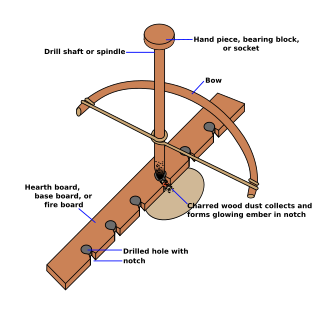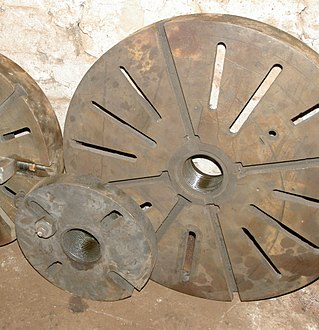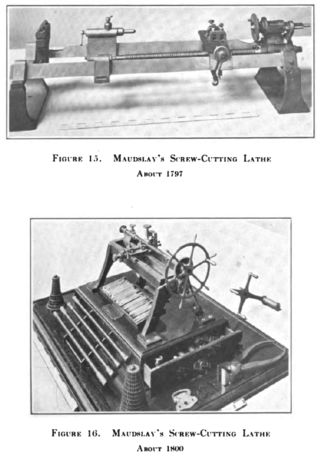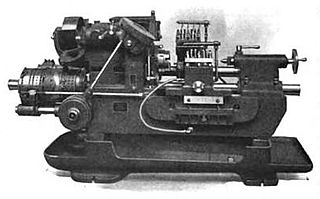
Spindle turning, or turning between centers, is a woodturning method referring to a piece of wood on a wood lathe that is being turned on its center axis. [1]
Contents


Spindle turning, or turning between centers, is a woodturning method referring to a piece of wood on a wood lathe that is being turned on its center axis. [1]

For spindle turning, the wood is held on the lathe either by both ends (between the headstock and tailstock) or by one end only using a lathe chuck [2]
Wood is generally removed by running a turning tool down the slope of the wood from a larger diameter in the wood to a smaller diameter.
Spindle turning is the method used for items such as chair and table legs, lamps, cues, bats, pens, candlesticks etc. i.e. long and thin objects.

A bow drill is a simple hand-operated type of tool, consisting of a rod that is set in rapid rotary motion by means of a cord wrapped around it, kept taut by a bow which is pushed back and forth with one hand. This tool of prehistoric origin has been used both as a drill, to make holes on solid materials such as wood, stone, bone, or teeth, and as a fire drill to start a fire.

A lathe is a machine tool that rotates a workpiece about an axis of rotation to perform various operations such as cutting, sanding, knurling, drilling, deformation, facing, threading and turning, with tools that are applied to the workpiece to create an object with symmetry about that axis.

A drill bit is a cutting tool used in a drill to remove material to create holes, almost always of circular cross-section. Drill bits come in many sizes and shapes and can create different kinds of holes in many different materials. In order to create holes drill bits are usually attached to a drill, which powers them to cut through the workpiece, typically by rotation. The drill will grasp the upper end of a bit called the shank in the chuck.

Woodturning is the craft of using a wood lathe with hand-held tools to cut a shape that is symmetrical around the axis of rotation. Like the potter's wheel, the wood lathe is a mechanism that can generate a variety of forms. The operator is known as a turner, and the skills needed to use the tools were traditionally known as turnery. In pre-industrial England, these skills were sufficiently difficult to be known as "the mysteries of the turners' guild." The skills to use the tools by hand, without a fixed point of contact with the wood, distinguish woodturning and the wood lathe from the machinist's lathe, or metal-working lathe.

A mandrel, mandril, or arbor is a tapered tool against which material can be forged, pressed, stretched or shaped, or a flanged or tapered or threaded bar that grips a workpiece to be machined in a lathe. A flanged mandrel is a parallel bar of a specific diameter with an integral flange towards one end, and threaded at the opposite end. Work is gripped between the flange and a nut on the thread. A tapered mandrel has a taper of approximately 0.005 inches per foot and is designed to hold work by being driven into an accurate hole on the work, gripping the work by friction. A threaded mandrel may have a male or female thread, and work which has an opposing thread is screwed onto the mandrel.

The phrase speeds and feeds or feeds and speeds refers to two separate parameters in machine tool practice, cutting speed and feed rate. They are often considered as a pair because of their combined effect on the cutting process. Each, however, can also be considered and analyzed in its own right.

A collet is a segmented sleeve, band or collar. One of the two radial surfaces of a collet is usually tapered and the other is cylindrical. The term collet commonly refers to a type of chuck that uses collets to hold either a workpiece or a tool, but collets have other mechanical applications.

A chuck is a specialized type of clamp used to hold an object with radial symmetry, especially a cylinder. In a drill, a mill and a transmission, a chuck holds the rotating tool; in a lathe, it holds the rotating workpiece.

A machine taper is a system for securing cutting tools or toolholders in the spindle of a machine tool or power tool. A male member of conical form fits into the female socket, which has a matching taper of equal angle.

Turning is a machining process in which a cutting tool, typically a non-rotary tool bit, describes a helix toolpath by moving more or less linearly while the workpiece rotates.
The shank is the end of a drill bit grasped by the chuck of a drill. The cutting edges of the drill bit contact the workpiece, and are connected via the shaft with the shank, which fits into the chuck. In many cases a general-purpose arrangement is used, such as a bit with cylindrical shaft and shank in a three-jaw chuck which grips a cylindrical shank tightly. Different shank and chuck combination can deliver improved performance, such as allowing higher torque, greater centering accuracy, or moving the bit independently of the chuck, with a hammer action.

A lathe center, often shortened to center, is a tool that has been ground to a point to accurately position a workpiece on an axis. They usually have an included angle of 60°, but in heavy machining situations an angle of 75° is used.

A lathe dog is a mechanical device typically made of cast iron, steel or aluminum that transmits rotary motion from a faceplate to a workpiece mounted between centers in a lathe. The tail of the dog is rotated by a slot in a driving faceplate, a stud mounted on a faceplate, or sometimes a side of a chuck jaw. The workpiece passes through an aperture in the dog into which the work is secured by one or more setscrews or a clamp arrangement. The maximum cross sectional dimension of the workpiece is limited by the dimensions of the dog aperture. Lathe dogs are provided in straight tail or bent tail form, and may be single tail or double tail. A lathe dog designed to hold square, rectangular or odd-shaped work and having a moveable portion secured typically by two cap screws is called a clamp dog. Bent tail dogs are able to engage directly with a driving faceplate slot or a chuck jaw but can crowd work off centre if clearance is not present between the dog tail and a closed end of the faceplate slot. Straight tail dogs do not present the issue of crowding work off centre but require at least one driving stud to be mounted on the faceplate. If the rotating mass of the dog setup is not balanced, eccentric motion of the work may occur. Counterbalancing or reduced spindle speed may be required. Care must be taken by the operator when using lathe dogs, as it is easy to get snagged on one. Use of headless setscrews, preferably of multiple-spline drive design, that do not protrude above the outer surface of the dog is recommended. A lathe dog may also be used with some indexing heads and other tools with similar faceplates that turn about a center.

In machining, a metal lathe or metalworking lathe is a large class of lathes designed for precisely machining relatively hard materials. They were originally designed to machine metals; however, with the advent of plastics and other materials, and with their inherent versatility, they are used in a wide range of applications, and a broad range of materials. In machining jargon, where the larger context is already understood, they are usually simply called lathes, or else referred to by more-specific subtype names. These rigid machine tools remove material from a rotating workpiece via the movements of various cutting tools, such as tool bits and drill bits.

A lathe faceplate is a basic workholding accessory for a wood or metal turning lathe. It is a circular metal plate which fixes to the end of the lathe spindle. The workpiece is then clamped to the faceplate, typically using t-slot nuts in slots in the faceplate, or less commonly threaded holes in the faceplate itself.

Segmented turning, also known as polychromatic turning, is a form of woodturning on a lathe where the initial workpiece is composed of multiple parts glued together. The process involves gluing several pieces of wood to create patterns and visual effects in turned projects.

A screw-cutting lathe is a machine capable of cutting very accurate screw threads via single-point screw-cutting, which is the process of guiding the linear motion of the tool bit in a precisely known ratio to the rotating motion of the workpiece. This is accomplished by gearing the leadscrew to the spindle with a certain gear ratio for each thread pitch. Every degree of spindle rotation is matched by a certain distance of linear tool travel, depending on the desired thread pitch.
The American Association of Woodturners (AAW) is the principal organization in the United States supporting the art and craft of woodturning. It is sometimes stylized as American Association of Wood Turners (AAW). Established in 1986 and headquartered in Saint Paul, Minnesota, the organization encompasses more than 15,000 members in the United States and many foreign nations. As of 2013, the AAW was affiliated with nearly 350 local chapters worldwide. In addition to sponsoring an annual national symposium, the AAW provides support to local clubs for outreach and education. The 25th anniversary of the AAW was celebrated in 2011 at the annual symposium held in Saint Paul. Phil McDonald is executive director of the organization.

Grinding is a type of abrasive machining process which uses a grinding wheel as cutting tool.

In metalworking and woodworking, an automatic lathe is a lathe with an automatically controlled cutting process. Automatic lathes were first developed in the 1870s and were mechanically controlled. From the advent of NC and CNC in the 1950s, the term automatic lathe has generally been used for only mechanically controlled lathes, although some manufacturers market Swiss-type CNC lathes as 'automatic'.